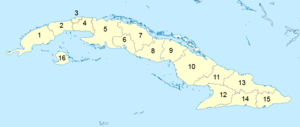Provinces of Cuba
| Provinces of Cuba Provincias de Cuba (Spanish) |
|
|---|---|
 |
|
| Category | Unitary state |
| Location | Republic of Cuba |
| Number | 15 Provinces |
| Populations | 84,263 (Isla de la Juventud) – 2,154,454 (La Habana) |
| Areas | 281.18 square miles (728.3 km2) (Isla de la Juventud) – 5,951.31 square miles (15,413.8 km2) (Camagüey Province) |
| Government | Dual-Party Government |
| Subdivisions | Municipality |
Administratively, Cuba is divided into 15 provinces and a special municipality that's not included in any province. The last modification was approved in August 2010 (by the Cuban National Assembly), splitting Havana province into two new provinces: Artemisa (which incorporates the three eastern municipalities of the neighbour Pinar del Río) and Mayabeque. The new provinces started functioning from January 1, 2011. Havana City Province (Ciudad de La Habana) recovered its original name: La Habana (Havana in English).
From west to east, Cuba's provinces are:
The provinces were created in 1879 by the Spanish colonial government. From 1879 to 1976, Cuba was divided into 6 provinces, which maintained with little changes the same boundaries and capital cities, although with modifications in official names. These "historical" provinces are the following (from west to east):
Pop. = Population. Source: Cuba census 2002
Presidents of the Provincial Assemblies of People's Power in each province in the country (local governments).
...
Wikipedia

